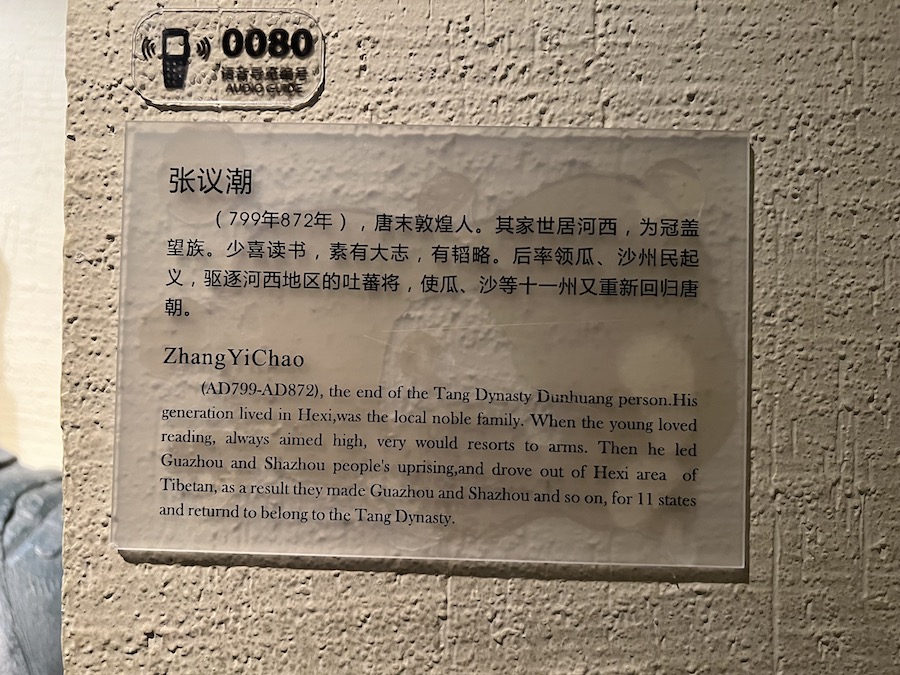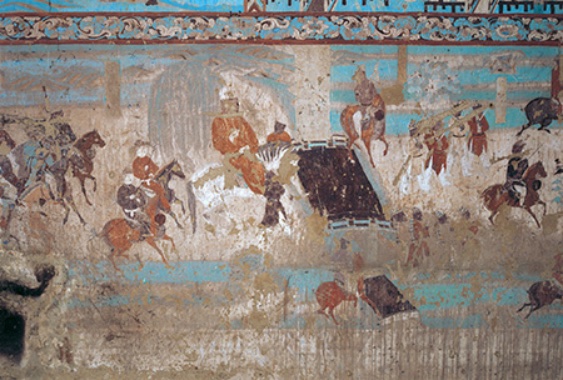A medieval Dunhuang man
« previous post | next post »
Bilingual label for a wall painting at the Mogao Caves in Dunhuang, Gansu, China:
The Chinese text reads:
Zhāng Yìcháo
(799 nián 872 nián), Táng mò Dūnhuáng rén. Qí jiā shì jū Héxī, wèi guāngài wàngzú. Shǎo xǐ dúshū, sù yǒu dàzhì, yǒu tāolüè. Hòu shuàilǐng Guā, Shā zhōu mín qǐyì, qūzhú Héxī dìqū de Tǔbō jiàng, shǐ Guā, Shā děng shíyī zhōu yòu chóngxīn huíguī Táng cháo.
张义潮
(799年872年),唐末敦煌人。其家世居河西,为冠盖望族。
Zhang Yichao
(799-872) A Dunhuang man of the late Tang. His family had lived in the Hexi Corridor for generations and were a decorated, distinguished family. When young, he was fond of reading books and all along had great aspirations. Versed in military strategy, later he led the people of Gua and Sha prefectures in a revolt, driving the Tibetan generals out of the Hexi region, causing the eleven prefectures of Gua, Sha, etc. once again to return to the Tang Empire.
Here are two Dunhuang murals, one of Zhang Yichao leading his troops, and one of his wife, Lady Songguo and her entourage going out on an excursion, respectively from the bottom portions of the southern and northern walls of cave 156:

(source of both photographs)
An annotated translation of the transformation text (biànwén 變文) on Zhang Yichao expelling the Tibetans from the Gansu Corridor may be found on pp. 167-171, notes on pp. 305-311 of Victor H. Mair, Tun-huang Popular Narratives (Cambridge [Cambridgeshire] ; New York: Cambridge University Press, 1983). This (Pelliot ms 2962) is a contemporaneous prosimetric, vernacular narrative derived from a local tradition of storytelling with pictures. For more on the Dunhuangological aspects of this type of literature, see the comments to this Language Log post.
Selected readings
- "Used to be a bun" (7/11/23 — In the comments: Historical novel by the Japanese novelist Yasushi Inoue called 敦煌 (“Tun-Huang,” in the English translation by Jean Oda Moy); Fujieda Akira, Dunhuang mss, history of Dunhuang; Hiroshi Kumamoto, Khotanese and other pre-modern Iranian languages; Nikita Kuzmin, Tangut inscriptions in and around Dunhuang
- "Somking" (7/7/23)
- "More savory Chinglish from Dunhuang" (7/9/23)
- "Acquiring literacy in medieval Dunhuang" (2/20/21)
- Victor Mair, "Reflections on the Origins of the Modern Standard Mandarin Place-Name 'Dunhuang' — With an Added Note on the Identity of the Modern Uighur Place-Name 'Turpan'", in Li Zheng, et al., eds., Ji Xianlin Jiaoshou bashi huadan jinian lunwenji (Papers in Honour of Prof. Dr. Ji Xianlin on the Occasion of His 80th Birthday) (Nanchang: Jiangxi People's Press, 1991), vol. 2, pp. 901-954 (very long and detailed study).
- Victor H. Mair, "Lay Students and the Making of Written Vernacular Narrative: An Inventory of Tun-huang Manuscripts", Chinoperl Papers 10 (1981), 5–96.
- "Involution, part 2" (12/25/20)


liuyao said,
July 20, 2023 @ 12:03 am
Thanks for a much better translation.
The new animated movie 长安三万里 about Tang poets is making a splash in Chinese theaters. (Their translation in subtitle is said to be pretty good; they simply rendered 吐蕃 as "Tubo". About 48 poems are featured in full.)